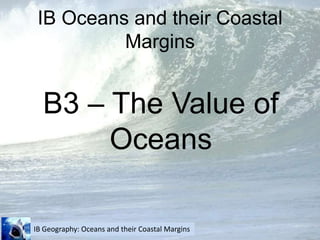
L08 geopolitics of oceans
- 1. IB Oceans and their Coastal Margins B3 – The Value of Oceans
- 2. World’s oceans represent a valuable resource base for the planet. Biotic – relating to living organisms Abiotic – non-living chemical and physical factors. Resource Base
- 3. Resources The world’s oceans provide many products that are useful for humans. Accessing resources is more difficult in the deep oceans than in the shallow continental shelves. The margins of the oceans have the greatest demands on them. As technology develops and cost structures change even the deepest and remote ocean areas are seen as being able to provide resources for human use.
- 4. Fishing Most useful biotic resource that the ocean provides for humans is fish. Fish supplies 16% of the world’s protein to humans. Fishing is conducted at a wide range of scales from individual people casting nets to large trawlers that operate like factories. Most fish are used for human consumption. Other use of fish are feeding animals or provide oils as raw materials for industrial processes.
- 6. Transport Although people tend to travel long distances by Air humans still use oceans for transport. Long-distance shipping is widely used to transport cargo in various types of ships including bulk oil tankers and container ships. Oceans are also used for communications as long-distance telephone, internet and data cables are laid across the ocean floor.
- 7. Tourism An increasingly important use for oceans as a resource. Most tourism related to oceans occurs on the margins, such as beaches and the shallow waters of the continental shelves. Some cruise liners carry passengers across the oceans between continents.
- 8. Abiotic Resources: Minerals Ocean resources are increasingly being used as a source for minerals. It is more difficult and more expensive to mine the oceans than the land. If the resource is significantly valuable it justifies the high cost. Unfortunately mining in the oceans often causes destruction of natural ecosystems. When dredging occurs the ocean floor is totally destroyed wiping out all marine habitats and breeding grounds.
- 9. Fishing Traditional fishing methods were defined to obtain food for subsistence purposes. Today fishing within most LEDCs takes only the quantities of fish needed for food in the local community. Under traditional fishing fish remains a renewable resource.
- 10. Commercial Fishing Commercial fishing provides an incentive to catch as many fish as possible to make as much money as possible. The fishing industry has a great difficulty conserving resources in part because fish can move across boundaries. Within any country their can be enforcement of rules about size of fish and bag limit. Actions can help to conserve fish stock in estuaries and coastal waters when there are sufficient inspectors to police regulations. Destruction of breeding habit may be counteracting conservation measures.
- 11. Fishing Stocks Fish may move great distances during their life cycle and this will mean crossing the boundaries of countries’ control. Territorial waters now extend some 320 kilometers from the shore and that means there is an overlap between many countries; or dispute where the line should be placed. Many countries enter other countries territorial waters and remove food and other sources of food. Patrolling can go some way to seeing that conservation measures are observed.
- 12. Dwindling Fish Stocks When fishermen are taking undersized fish stocks near an ocean border they are depleting breeding stock on both sides. Much more efficient techniques have been developed in recent years: Air and radar surveillance to locate fish schools. Larger, faster, better equipped factory ships to process and preserve the catch. Better netting techniques that often require the team work of a number of fishing boats.
- 13. Increasing Fishing As well as fishing becoming more intensive the size of the world fishing fleets grew enormously. Fish can now be caught in quantities that threaten the survival of species. Drift net is still being used by fishers from some countries despite being banned in international agreements. The drift net is almost invisible and snares virtually everything that is unluckily enough to swim into it. The drift net cannot exclude protected species.
- 14. Special Fish There are special markets for particular fish, such as tuna in Japan or the coral trout in Hong Kong. The price that fishers can obtain encourages them to take greater risks of breaching territorial waters. Coral trout has been taken from the protected marine park of the Great Barrier Reef to appear later in Hong Kong restaurants as the result of illegal fishing. The price that people are willing to pay influences whether conservation will be successful.
- 15. Conservation of Fisheries Conservation measures are only having a minor impact. Trend in marine fish catches has been downwards since about 1970 – though there is a greater success in catching what fish are actually there. Traditional fish sought by the industry are over exploited. Size of the catch is being maintained by some non-traditional species such as sprat or Pollock. This will allow the size of the yield to be maintained though not through active conservation.
- 16. Whaling Breaches of restrictions on whaling receive more publicity than the steep reductions in the stocks of fish. Conservation of Whaling has been successful in terms of conservation. Japan and Norway still do not recognise some international agreements. Numbers of whale species have shown a steady increase in their last two decreases. Many places they contribute to ecotourism as people are fascinated by them.
- 17. Question Describe the issues involved in the management of fish as a resource?